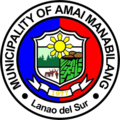Top Qs
Timeline
Chat
Perspective
Amai Manabilang
Municipality in Lanao del Sur, Philippines From Wikipedia, the free encyclopedia
Remove ads
Amai Manabilang, officially the Municipality of Amai Manabilang (Maranao: Inged a Amai Manabilang; Tagalog: Bayan ng Amai Manabilang), is a municipality in the province of Lanao del Sur, Philippines. According to the 2020 census, it has a population of 12,124 people.[5]
This article needs additional citations for verification. (June 2014) |
The municipality, formerly Bumbaran, was changed to Amai Manabilang under Muslim Mindanao Act No. 316 on January 22, 2015.[6]
Remove ads
Etymology
Bumbaran is named after the legendary city of Magalinday Bembaran in the Darangen, a Meranau (Maranao) epic. The scenic beauty of the town resembles the beauty of Magalinday Bembaran.
After the political efforts of Mayor James Manabilang, Bumbaran was renamed into Amai Manabilang, in honor of his own personal ancestor.
History
Bumbaran was commonly known before as “Aparport” its seat of government. Its existence came into being when President Ferdinand Marcos signed into law on November 17, 1977, Presidential Decree No. 1243 creating Aparport a separate and independent municipality and naming it the Municipality of Bumbaran, separate from the Municipality of Wao, its mother municipality. This was necessary in order to maximize the enforcement of law and order and expedite optimum and sustainable development.[7]
At that time, the municipality consisted of 21 barangays namely: Sumogot, Francfort, Lambanogan, Punud, Comara, Aparport, Paglamatan, Natangcopan, Mansilano, Salam, Bandara-Ingud, Ranao-Ibaning, Bagumbayan, Pagonayan, Piagma, Lico, Siuan, Lama, Borntacan, Miorod, and Someorang.[7] It was reduced to seventeen barangays when President Corazon Aquino signed an Executive Order in December 1986 abolishing thousands of barangays in the country which affected barangays Lama, Miorod, Borontacan, and Someorang.[citation needed]
On January 22, 2015, Bumbaran was renamed to Amai Manabilang by virtue of Muslim Mindanao Act No. 316. It was later confirmed through a plebiscite held on April 7, 2018.[6]
Remove ads
Geography
Summarize
Perspective
The municipal boundaries are defined as follows: on the east by the municipality of Wao, separated by a straight line 13.65 kilometers (8.48 mi) long, drawn northward from Point 1 to Point 2 on the bank of the Maladugao river 1.5 kilometers (0.93 mi). East Sumogot on the Lanao–Bukidnon boundary as point 3; then by straight line following the Lumba-Bayabao–Wao boundary line. Southward of the intersection of the Lanao–Cotabato boundary as point 4; then finally 1.72 kilometers (1.07 mi). Eastward following the Lanao–Cotabato boundary to the starting point.[7]
Barangays
Amai Manabilang is politically subdivided into 17 barangays. Each barangay consists of puroks while some have sitios.
- Bagumbayan
- Bandara-Ingud
- Comara (Potre Maamor)
- Francfort
- Lambanogan
- Lico
- Mansilano
- Natangcopan
- Pagalamatan
- Pagonayan
- Penud
- Piagma
- Poblacion (Apartfort)
- Ranao-Baning
- Salam
- Sigu-an
- Sumogot
Climate
The town's climate is similar to that of Baguio.
Demographics
Summarize
Perspective
Religion
Amai Manabilang is composed of two major groups – 99% Muslim Bangsamoro and 1% Catholic. Catholics inhabited barangays Sumogot and Francfort. The Muslim Bangsamoros occupied the rest of the 17 barangays.[14]
Ethnic groups
Amai Manabilang is inhabited by settlers of different origins, like Ilonggos, Ivatans, Ilocano, Bisaya and other smaller ethnic groups that dominated barangays Francfort and Sumugot. This is due to the Settlement Program and Land Tenure Laws[14] of the Republic of the Philippines. The Moro Maranaws who came from the different municipalities of Lanao del Sur and Lanao del Norte inhabited the rest of the seventeen barangays of this municipality. Their source of livelihood is farming, mainly crop production. Having rich soil, the municipality is one of the largest corn producers in the province, only second to its mother municipality of Wao for having vast agricultural land capable of producing variable crops which could give sufficient food and income to the population.
Remove ads
Economy
Poverty Incidence of Amai Manabilang
10
20
30
40
50
60
70
80
2000
77.16 2003
58.90 2006
34.10 2009
37.76 2012
62.68 2015
53.67 2018
75.74 2021
31.97 Source: Philippine Statistics Authority[15][16][17][18][19][20][21][22] |
References
External links
Wikiwand - on
Seamless Wikipedia browsing. On steroids.
Remove ads





